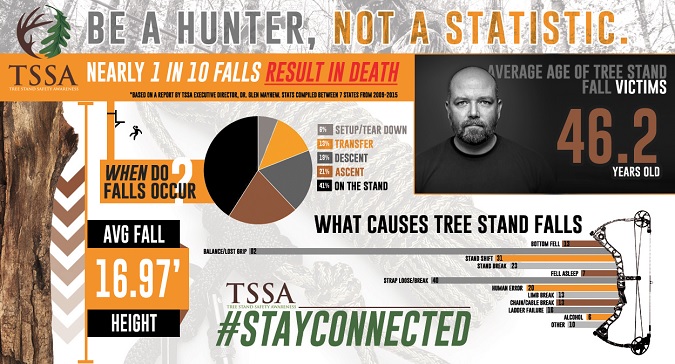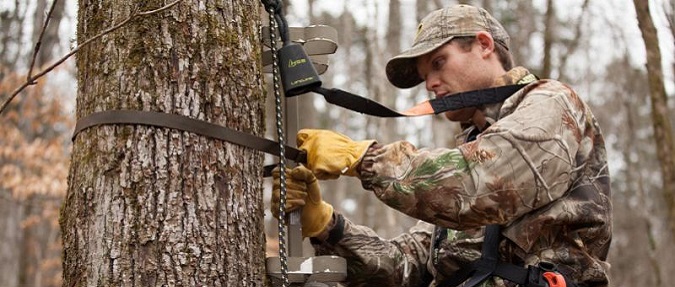Opening day for most hunters is right around the corner, and that means deer season preparations are well under way. Some of you have been preparing since last season ended, while others are just getting started. To ensure we’re ready for the big day, we carve out time to shoot our bows and firearms, hang stands, trim shooting lanes and run as many trail cameras as our budget will allow. Countless hours go into preparing for a successful deer season. But have you put in the hours to ensure a safe deer season? More important than bringing home that buck of a lifetime is returning home safe and sound at the end of every day afield. Here are four ways to make sure you do just that.
1) Check Your Stands
Whether you pack a climber in with you each time you hunt or use hang-on stands that have been in place since last season, be sure to check your equipment thoroughly. On the stand itself, be on the lookout for any cracks in the metal or the welds and any bolts or clips that may need replacing. If you use a climbing stand, you’ll also want to check the band or cable that attaches the stand to the tree for any wear or damage that could potentially cause it to fail. On hang-ons and ladder stands, pay careful attention to the straps or chains that hold the stand to the tree. This is especially true if you leave your stands out year-round. If the straps appear even the least bit stretched, frayed or dry-rotted, replace them with new ones. The cost of a few ratchet straps is a small price to pay to prevent a treestand fall.
2) Always Use A Safety Harness and Lifeline
Despite the fact that most every hunter has either fallen from a treestand or knows someone who has, many still refuse to wear a safety harness when they hunt. It’s reckless, and there is no excuse for it. With today’s access to a variety of affordable safety harnesses, there’s no reason we — as deer hunters — shouldn’t be able to get through an entire season without a single treestand fatality nationwide. I hope I live to see that day. If you don’t already have one, get a good, comfortable full-body harness that can be used with a lineman’s belt for hanging stands and steps. If you hunt from hang-ons or ladder stands that you leave out, be sure to invest in some Hunter Safety System Lifelines that allow you to remain connected to the tree from the time you leave the ground until the time you return. It’s not enough just to strap in once you get into your stand, because most falls occur climbing into or out of the stand (for more statistics, see the excellent infographic below, courtesy of the TSSA).

3) Hang Your Stands With Care
Where and how you hang your stands can also play a role in keeping you safe this deer season. Start by choosing a tree that’s safe. First and foremost make sure the tree is alive! Check for any sign of rot or any cavities that may indicate the tree is at least partially hollow. Also look for any dead limbs above that could come down during a hunt. If there is any question at all about the reliability of the tree, find another one.
Once you’ve found a safe tree, make sure you are attached to that tree the entire time you are hanging a new stand. This can be done with a lineman’s-style belt attached to your safety harness.
When hanging a lock-on stand, I always make sure the stand is hung well below the top of my climbing sticks so I can easily step over and onto the stand without having to lift my leg up or stretch, which could result in a fall. And while many hang-on stands only come with one strap to hang the stand, I always add a second near the bottom of the stand to stabilize the platform and avoid any potential for the stand to shift while I’m on it. (A locked security cable can provide extra fall-prevention as well as theft-prevention.)
4) Let Someone Know Where You’ll Be
After turning 40 and hearing numerous stories of guys falling from stands or having heart attacks in the woods, I decided it would be a good idea for someone to know where I am and when I plan to be home every time I hit the woods. For me, that someone is my wife. Since I mainly hunt public land, my potential hunting spot can quickly change if someone is hunting where I was planning to go. As soon as I get to where I’m going, I use Google Maps on my smartphone to drop a pin at my location, which I then text to my wife. If something were to happen to me, she could provide emergency responders with the corresponding GPS coordinates, and they could walk right to me. It only takes a few seconds of my time and gives both me and my wife some peace of mind about my safety. If you aren’t tech savvy or if you hunt the same area every time, then a simple hand-drawn map to your location will work just fine.
I truly hope each of you has a successful season this fall. May your freezer end up full of fresh venison and your taxidermist stay busy mounting that buck of a lifetime. But more importantly than that, I hope each of you has a safe hunting season. Let’s make this the year that no one has to bury a spouse, child or parent because of a preventable hunting mistake.









